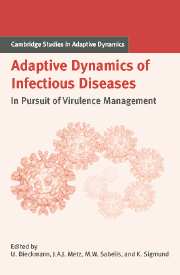Book contents
- Frontmatter
- Contents
- Contributing Authors
- List of Boxes
- Notational Standards
- 1 Introduction
- A Setting the Stage
- B Host Population Structure
- C Within-Host Interactions
- D Pathogen–Host Coevolution
- E Multilevel Selection
- F Vaccines and Drugs
- G Perspectives for Virulence Management
- Introduction to Part G
- 27 Taking Stock: Relating Theory to Experiment
- 28 Virulence Management in Humans
- 29 Virulence Management in Wildlife Populations
- 30 Virulence Management in Veterinary Epidemiology
- 31 Virulence Management in Plant–Pathogen Interactions
- 32 Virulence Management in Biocontrol Agents
- 33 Epilogue
- References
- Index
- International Institute for Applied Systems Analysis
27 - Taking Stock: Relating Theory to Experiment
Published online by Cambridge University Press: 15 January 2010
- Frontmatter
- Contents
- Contributing Authors
- List of Boxes
- Notational Standards
- 1 Introduction
- A Setting the Stage
- B Host Population Structure
- C Within-Host Interactions
- D Pathogen–Host Coevolution
- E Multilevel Selection
- F Vaccines and Drugs
- G Perspectives for Virulence Management
- Introduction to Part G
- 27 Taking Stock: Relating Theory to Experiment
- 28 Virulence Management in Humans
- 29 Virulence Management in Wildlife Populations
- 30 Virulence Management in Veterinary Epidemiology
- 31 Virulence Management in Plant–Pathogen Interactions
- 32 Virulence Management in Biocontrol Agents
- 33 Epilogue
- References
- Index
- International Institute for Applied Systems Analysis
Summary
Introduction
This book is concerned with the way natural selection affects the virulence of disease agents, here loosely defined as damage to the host, and with how we can use this knowledge to design strategies for managing virulence. These questions are rooted in Darwinian thinking about evolution (Poulin 1998; Stearns 1999). If it were possible to resolve these questions at the level of evolutionary storytelling only, this book would not exist. The impetus behind this book came from recent advances in mathematical evolutionary theory, in particular the ongoing merger of the theories of population dynamics and natural selection. This merger enables quantitative, and therefore testable, predictions of the outcome of selection for a given ecological setting. As so often, applied problems form an ideal testbed for the new tools.
Since disease agents have short generation times and usually harbor considerable genetic variation, natural selection can potentially cause rapid changes in the genetic make-up of pathogen or parasite populations. Therefore, the evolution of parasite virulence is an obvious area to test new evolutionary theories. Another matter is whether such tests promise immediate applications. The theory of evolutionary dynamics is not at a stage that can produce lists of management strategies to solve any particular problem with certainty; to be fair, is any theory able to? However, any measure, even the considered absence of action, is guided by some theory in whatever verbal or mathematical form.
- Type
- Chapter
- Information
- Adaptive Dynamics of Infectious DiseasesIn Pursuit of Virulence Management, pp. 379 - 398Publisher: Cambridge University PressPrint publication year: 2002
- 4
- Cited by



